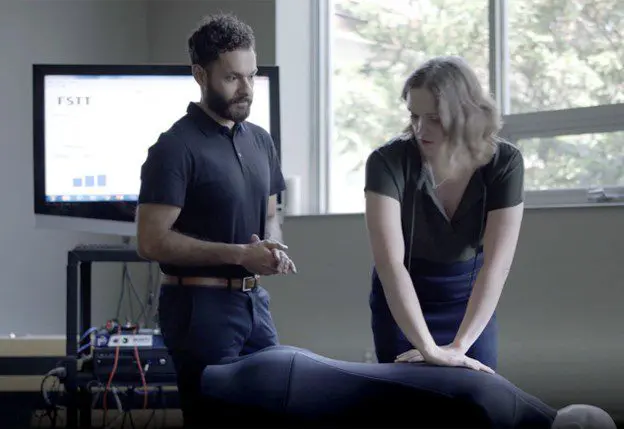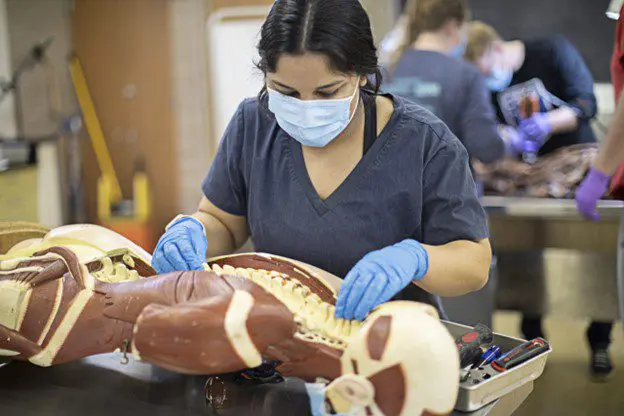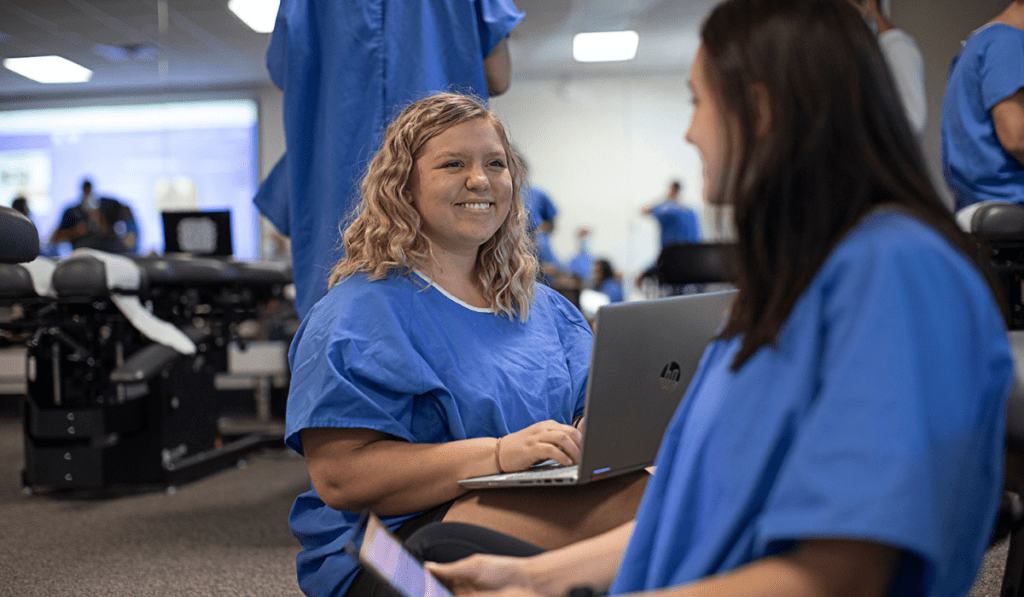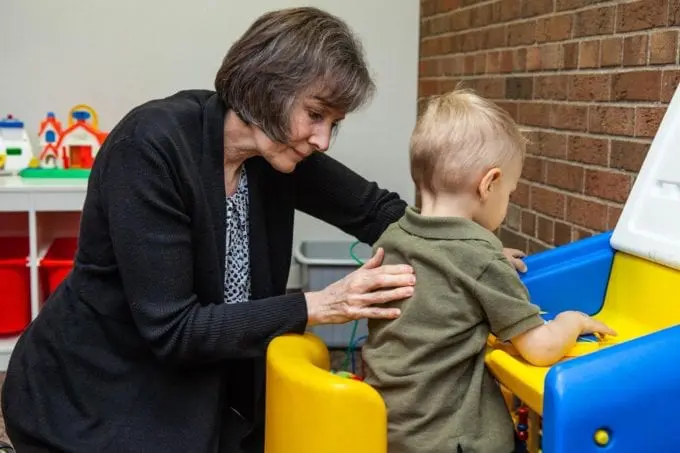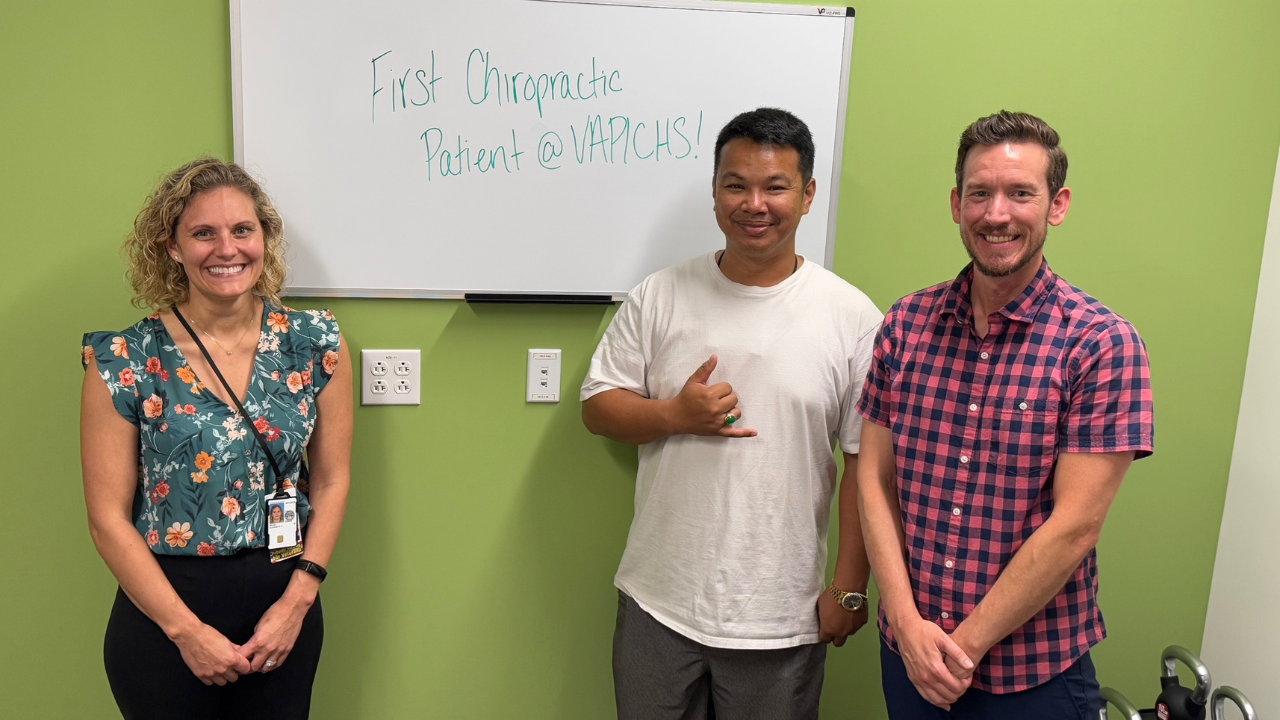What to Look for in a Chiropractic Program: 14 Essential Questions to Ask
To become a chiropractor, you’ll first need to complete a Doctor of Chiropractic (D.C) degree program. But which program should you choose? In the following, we’ll help you answer that question by exploring what to look for in a chiropractic program.
The field of chiropractic care has a bright future as more and more people demand noninvasive healthcare options. In fact, the Bureau of Labor Statistics projects an 9% growth rate for the profession over the next decade.
How well a chiropractic school program prepares you to be a part of that future will depend heavily on the quality of your learning experience. Let’s take a close look at the questions you should be asking as you consider enrolling in a Doctor of Chiropractic program/emphasis.
Continue reading for answers to each question or click the links below to jump to specific questions.
- School Accreditation
- Program Length
- Dual Degree Options
- Tuition and Fees
- Clinical Experience
- Courses and Lab Education
- Internship
- Importance of Faculty
- School Location
- School Philosophy
- School resources and facilities
- Board Scores
- Student Services
- Admissions Info
1. Is the school you wish to attend accredited?
You’ll want to attend a school that meets official standards established within the chiropractic profession. Be sure the school you choose is accredited by the Council on Chiropractic Education. You will often find this information on the school website and specifically on a program page. This information should be easy for you to spot. If you have any issues confirming school accreditation, reach out to an admissions team member.
The Doctor of Chiropractic degree program at NWHSU is awarded programmatic accreditation by the Council on Chiropractic Education (10105 E. Via Linda, Suite 103 – 3642, Scottsdale, AZ, 85258-4321; Phone: 480.443.8877; Website: www.cce-usa.org.)
2. How long will it take to earn your Doctor of Chiropractic Degree?
Accredited Doctor of Chiropractic degree programs must provide a minimum of 4,300 instructional hours. Some programs extend their curriculum over a longer period of time and can take as many as five years to complete.
Others cover more ground in a shorter period and take significantly less time. At NWHSU, you can complete your chiropractic degree in about three and a half years. Students attend classes year-round, have shorter breaks, and carry a heavier course load.
Note that there are a number of advantages to this:
- Faster completion time means graduating with less student loan debt.
- You can begin your professional career sooner.
- The rigorous coursework and faster pace can better prepare you for the professional environment you’ll enter.
3. Does the program offer dual degree options and specialized areas of focus?
What kind of chiropractor do you want to be? You have the potential to practice in a wide range of environments, specialize in treatments, and focus on specific patient populations. A program that offers specialties, dual degree options, and other ways to customize your chiropractic education can help you establish a career path that’s right for you.
For instance, NWHSU has a widely respected Sports Emphasis chiropractic degree that prepares students to treat athletes. Also, to save students both time and program costs, we offer numerous dual degree options through a variety of academic partnerships.
Plus, we provide a degree completion option for a Bachelor of Science in Human Biology that you can take concurrently with the Doctor of Chiropractic program.
4. How much will it cost?
For a prospective student, this question should encompass not only tuition and fees but also all the other expenses that will be involved in attending school. For example, if you’ll be relocating, what is the cost of rent?
Keep in mind that a chiropractic program should be as transparent as possible as it clearly lays out just how much it will cost to attend.
Make sure you incorporate financial concerns into your search early on. The best place to start is with a school’s financial aid specialists. And be sure to also research both school-sponsored and external scholarships.
5. What kinds of clinical experiences will you have while a student?
Be sure to familiarize yourself with what a given program offers in terms of clinical experiences. Some chiropractic programs may only expose you to one clinical environment. Alternatively, other programs make it a priority to offer students an array of hands-on clinical experiences.
NWHSU, for example, provides one of the most extensive clinical internship programs in the country for chiropractic students. More specifically, it empowers students to customize their experiences based on their interests—as well as make discoveries along the way that can shape the future of their careers.
Here are some important details on why a variety of clinical experiences can play a crucial role in your chiropractic education:
You’re exposed to different environments
What kind of professional environment do you see yourself eventually working in? Although opening a private practice is common for chiropractors, more and more are now administering treatment in a multitude of other healthcare settings. You’ll gain an advantage by being exposed to a variety of them.
Also, as a student you may have preconceived ideas about the settings that are right (or wrong) for you. But this is precisely why being immersed in different clinical environments can be eye-opening, and even life-changing.
At NWHSU, thanks to partnerships with more than 150 healthcare organizations in the Twin Cities Metro Area and beyond, students can gain valuable, real-life clinical experiences in places such as:
- Group practice offices, where multiple chiropractors provide care
- Integrative clinics, where chiropractors and other healthcare professionals like massage therapists and acupuncturists provide care
- Primary care clinics
- Multidisciplinary clinics
- Hospitals
- VA Medical Centers
- Corporate settings
- Fitness centers
- Sports team facilities
The benefits of university-affiliated clinics. In addition to our community-based internships, NWHSU also has multiple clinics of its own, both on and off campus, that serve the public.
These enable our chiropractic students to conveniently work with supportive NWHSU clinicians while also gaining hands-on experience with real patients.
NWHSU also has the sports-focused Human Performance Center on campus, which provides an incredible opportunity for students interested in specialized areas of chiropractic care such as sports medicine and injury rehabilitation. (Note: NWHSU offers a Doctor of Chiropractic – Sports Emphasis degree, in addition to our Doctor of Chiropractic degree.)
Learn more about the Human Performance Center in this brief video.
You’re exposed to different patient populations
Chiropractors can treat a broad spectrum of patients. Some find that specializing in a specific patient population is right for them. But as a student, how can you know if such a path could be of interest to you?
Your clinical experiences can play a pivotal role—if you’re exposed to a variety of patient populations.
At NWHSU because of the breadth of community-based internship opportunities offered, students have the chance to work with many different patient types. Here are some examples:
- Athletes
- Children
- Seniors
- Veterans
- Cancer patients
- Pregnant women
- Women with fertility issues
- Underserved populations (e.g., people who are homeless, families with low income)
Here’s a related point to keep in mind. Unlike some programs, NWHSU doesn’t require students to recruit patients. We have a vast network of connections with healthcare organizations and a well-established patient base.
Watch Dr. Brittany Schmidt, a former NWHSU chiropractic student, describe her valuable internship experience.
You’re exposed to different healthcare disciplines
We’re entering an exciting new era with the advent of integrative healthcare, a patient-centered, team-based approach involving practitioners from various fields working together to help patients.
Increasingly, chiropractors today routinely communicate with—and in some cases work alongside—healthcare professionals from other disciplines. That’s why it’s so important to have an educational experience that prepares you for integrative healthcare.
Why NWHSU’s focus on health sciences matters. NWHSU is 100% focused on the health sciences as it trains the next generation of healthcare professionals—not only chiropractors but also:
- Acupuncturists
- Massage therapists
- Functional nutrition experts
- Allied health professionals such as radiation therapists, lab scientists, and medical assistants
At NWHSU, chiropractic students can study alongside healthcare-focused students from various disciplines. They even get opportunities to practice with, for example, acupuncture and massage therapy students in our on-campus clinics, plus work in multidisciplinary healthcare environments, depending on the internships they choose. By the time a chiropractor student graduates from NWHSU, they’re more than just ready to practice in their field.
They have a significant grasp of other healthcare perspectives, understand how to build relationships and communicate effectively with other healthcare practitioners, and are better prepared to practice an integrative healthcare approach—all for the purpose of providing the best care to patients.
6. How are courses and labs taught?
As you’re researching chiropractic programs, find out how courses and labs are taught. This will vary from program to program and is an especially important consideration in a COVID-19—and post-COVID-19 world.
NWHSU offers a carefully designed hybrid learning approach that delivers the best of both worlds—the benefits of in-person instruction and the convenient flexibility of online learning:
- Learn on campus (primarily Tuesdays, Wednesdays, and Thursdays) for hands-on labs as well as specific subjects such as biochemistry and anatomy.
- Log in at designated times to participate in live online lectures and discussions—from wherever you like.
- View and re-view pre-recorded lectures and hands-on demonstrations that are well-suited for online learning—at any time of the day (or night) that’s convenient for you.
Note that NWHSU consistently delivers learning that ranks us among the top programs for student licensing exam results—a great indicator that students are prepared for career success.
Also, 95% of December 2021 graduates had secured or were close to securing a chiropractic position.
The NWHSU learning model regularly flexes to student needs based on their learning results and the feedback they provide about their experience.
7. How early can you gain exposure to real-life observation, hands-on instruction, and internship opportunities?
Chiropractic care is quite literally a hands-on medicine. That’s exactly why you want to look for a chiropractic program that provides ample learning experiences to both observe chiropractors administering treatment and practice those hands-on techniques yourself.
To give you an idea of what that looks like, consider the carefully sequenced approach at Northwestern Health Sciences University ‘s Chiropractic School (NWHSU):
Immediate clinical observation (trimesters 1–5)
Starting in trimester one (T1), students begin observing chiropractic doctors treating patients in their private practices and at NWHSU’s on-campus clinics. Students start learning to think like a chiropractor through these immersive observation experiences.
In T3, students participate as assigned patients to T6 students. At this stage, T3 students benefit from receiving care as well as focusing their attention on the communication techniques, documentation, and treatment strategies being carried out. These are topics they’re also covering in their courses.
Continued observation to build skills, plus the first real internship (trimesters 4–6
In this phase, students increase their clinical skills as they continue to observe and begin assisting chiropractic doctors, who serve as mentors as they guide students through all aspects of patient care.
Note that in this phase T6 students benefit from having their first patients be T3 students (see section above). The T6 students receive more in-depth feedback than from typical patients because the T3 students have a better understanding of chiropractic care.
Internships to bring it all together (trimesters 7–10)
Students now take on greater levels of responsibility and gain more confidence as they care for patients. In the process they not only become more technically proficient but also more effective in communicating with patients and knowledgeable about managing a chiropractic practice.
Here’s a more detailed breakdown of this final phase:
Trimester 7:
Students participate in an internship at the De Rusha Clinic on campus for four hours a week, providing care to the campus community. This is in addition to providing active care (similar to rehabilitative care) one hour per week. Note that very few chiropractic programs provide an active care focus to an entire cohort the way NWHSU does. Students also spend one hour a week working with x-ray technology by taking radiological images for NWHSU patients.
Trimester 8-10
During T8, students spend 18+ hours per week in either an NWHSU campus clinic or a community-based clinic. By T9 they’re spending 21+ or more hours/week in a clinical setting and then 25–40 hours by their final trimester (T10). (See No. 2 below for more details on the importance of a program’s internship opportunities.)
Additional considerations include the following:
Student-to-faculty ratio for clinical experiences
Be sure to ask about the student-to-faculty ratio for your initial internship.
In a chiropractic student’s first internship experience at NWHSU, for instance, the ratio of student to faculty is 1:1. This allows individualized instruction and direct, immediate feedback as a student practicing chiropractic techniques. Clinical internships through NWHSU will rarely ever exceed five students per one clinician, which continues to create an intimate learning environment with plenty of personalized attention.
Opportunity for open labs
It’s understandable that students want lots of hands-on learning opportunities, even beyond their formal lab courses and internship experiences. At NWHSU, we encourage students to take advantage of our supervised open lab times. Here, they can practice in a low-stress learning environment while being supervised by chiropractic faculty who volunteer their time to help students improve their skills.
We also provide additional lab time with force-sensing table technology, a cutting-edge instructional tool that allows students to gain immediate feedback about the force, depth, and pre-stress of their chiropractic adjusting techniques. (See No. 3 below for related information.)
8. Who are the faculty that will be teaching you?
As you explore chiropractic programs, try to gain a solid understanding of the faculty who could be teaching you. In fact, make the effort—if possible—to get to know your potential instructors before you commit to a program. Ideally, you want an accessible faculty with flexible office hours who are dedicated to helping you succeed.
At NWHSU, our accomplished clinician-educators do more than teach—they’re committed to mentoring students.
They’re also leaders in chiropractic studies, advancing the field not only through their instruction but also through research and peer-reviewed publications, legislative activism, and healthcare education efforts in the community.
NWHSU faculty highlights include:
- Insight and experience to prepare students for the future of healthcare—more specifically, to practice integrative, patient-centered chiropractic care.
- Award-winning chiropractic educators who publish peer-reviewed research.
- Healthcare professionals with specialized training in areas such as pathology, radiology, pediatrics, and sports-related injuries.
- A 12:1 faculty-to-student ratio, which gives students the advantage of a close-knit educational environment where small group and one-on-one learning opportunities are the norm.
Learn more about the faculty here.
9. Where is the chiropractic program located?
Think through the implications of where you’ll be attending chiropractic school. Take NWHSU as an example:
A healthcare hub. NWHSU is located in the Twin Cities Metro Area, a major center of progressive healthcare innovation within a state that includes healthcare industry leaders such as the Mayo Clinic and Medtronic. In fact, Minnesota was ranked the No. 1 Best State for Health Care in 2020 because of its exceptional healthcare system and its residents’ healthy way of life.
NWHSU has cultivated partnerships with numerous healthcare-related organizations in the region, giving students more opportunities to make connections, gain valuable experience, and plan their future.
10. What is the school’s chiropractic philosophy?
Chiropractic schools have obvious similarities with one another. After all, their goal is to prepare students for the chiropractic profession. Yet they can also differ in profound ways.
As you familiarize yourself with a prospective program, try to understand the school’s educational approach and its adherence to any one philosophy on chiropractic care.
You can do that by exploring questions like these:
- How does it view the role of a chiropractor in a person’s overall healthcare?
- How grounded in the sciences is it?
- How important are evidence-based methods in the school’s program?
At NWHSU, we focus on science and seek evidence to support the way we treat our patients. We do not promote any one specific chiropractic philosophy. Rather, we foster critical thinking and intellectual honesty. We also strive to evolve in ways that ultimately provide improved chiropractic care to patients. While we honor our rich chiropractic history, we are not defined by it. Instead, we focus on creating an academic environment where ideas can be explored and debated.
11. What’s the school like in terms of its resources and facilities?
As you explore possible chiropractic programs, try to learn about the resources and facilities available to help you on your path to ultimately becoming a successful chiropractor.
To help understand what a chiropractic school can offer, here are some highlights of NWHSU.
- World-class university offerings. Although class sizes are relatively small, NWHSU is a large facility with on-campus healthcare clinics, technology-enhanced classrooms, and an extensive research library. More specifically, learning resources for chiropractor students at NWHSU include:
- Force-sensing table technology. This amazing instructional tool helps students begin learning the science (and art) of chiropractic adjustments. Learn more in this video.
- A radiology lab. Imaging and radiology instruction are interwoven into a student’s chiropractic education at NWHSU. See how in the following video.
- Multiple on-site clinics. NWHSU’s on-site clinics provide students crucial real-life clinical experiences, starting in the first trimester. This video provides a helpful overview.
- A brand new anatomy lab. Students gain a deep understanding of the human body thanks to outstanding instructors and a cutting-edge learning environment. Our new anatomy lab is a great example. Check out this video for more details.
12. What is the program’s national ranking of Chiropractic Board scores?
A chiropractic program should help instill students with a solid foundation of knowledge and understanding so that they are well-prepared for board exams—and a chiropractic career.
That’s why you’ll want to attend a program that thoroughly prepares students to navigate the National Board of Chiropractic Examiners (NBCE) and earn their licensing process.
Check to see where a given chiropractic school ranks on average NBCE board scores. This is one important reflection of a program’s effectiveness. NWHSU, for instance, ranks No. 2 nationwide in board scores.
13. What student services are offered?
Keep in mind that being a student involves a lot more than completing assignments and attending classes. Make sure to explore how a given school or university can help you make the most of your student experience.
What opportunities are there to get involved more deeply with the student community? What kind of student services does the school you’re looking at offer?
At NWHSU, the Office of Student Affairs has a wide range of programs and services that not only enhance your student experience but also help you prepare for your career.
Here are highlights:
Student clubs and organizations. NWHSU has over 50 clubs and organizations available that cover a wide range of interests and give you a chance to pursue topics beyond those taught in your courses.
Student Senate. By participating in the Student Senate, students can help determine how they experience life at NWHSU. They also serve as a liaison between the student body and the larger community, helping to plan student and community events.
Career Services. Students can receive one-on-one career counseling; check out career fairs; attend workshops to prepare for job interviews; and search for job opportunities more efficiently with the members-only job platform Handshake.
Counseling Center. Students have access to no-cost mental health counseling, both on campus and online, as well as a network of community-based resources.
Alumni Services. After students complete their chiropractic program at NWHSU, they can continue to look to NWHSU for support with career development. Plus, they can stay up to date on continuing education opportunities in chiropractic care. Former students even have access to healthcare through the De Rusha Clinic.
The above are in addition to Academic Support services such as tutoring, which is available at no cost to all students.
14. Can I easily learn more about the program and the school?
You’re making a profoundly important investment in your future when you enroll in a chiropractic program. So, it’s well worth your time to seize the opportunities you have to better understand the program and the learning environment. Does it provide convenient ways for you to do that?
NWHSU puts on multiple admission events a year for prospective students, in addition to virtual events.
You can also schedule a campus tour, in person or virtually, and set up phone call appointments to talk to an admission counselor and a current student.
Take the next step toward your future
Exploring the possibility of a chiropractic career is an exciting time! You’ve just absorbed a lot of helpful info on what to look for in a chiropractic program. Want help putting it all in perspective? Do you have questions about your specific situation?
This is the perfect time to take the next step.
Reach out to NWHSU for personalized support to better understand what our chiropractic program has to offer you. You may also consider visiting campus at our next Discovery Day event. An event for prospective students to tour campus, connect with department leadership and faculty in a desired program, and meet with additional staff including admissions and financial aid.
LEARN MORE About Our Chiropractic Program
Guide originally published in January 2022 and updated in May 2024.

